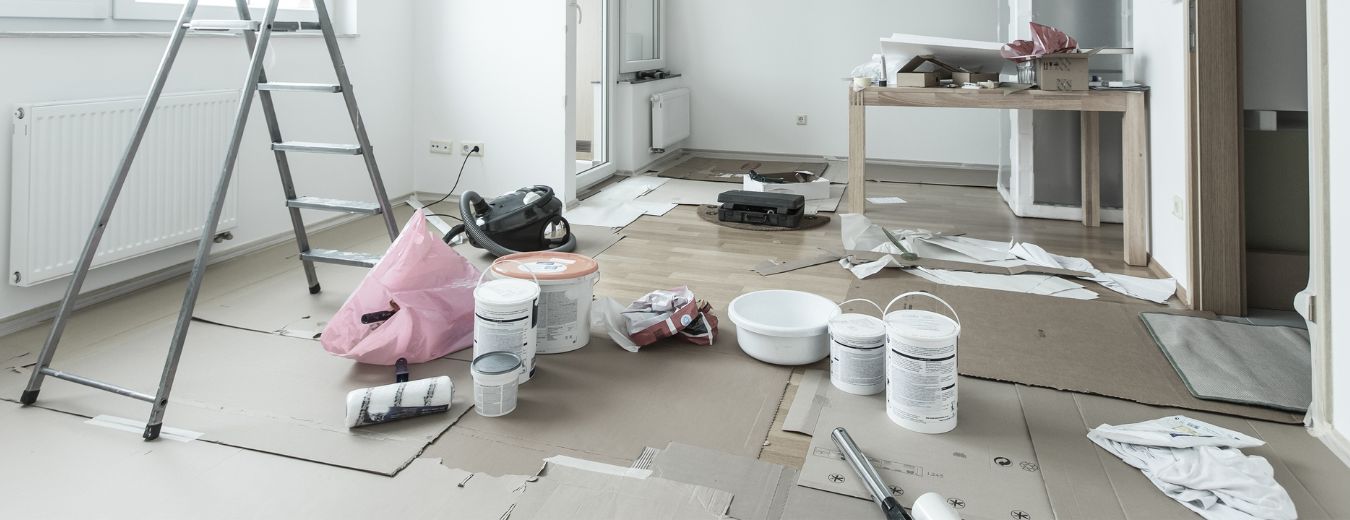
Health and Safety tips for painting your home
Posted on August 2, 2021
Planning your next painting project? here are a few things to consider in the way of health and safety for you, your family, and your pets before you get started. Follow these suggestions to prevent accidents and minimize any health risks to you and your loved ones.
Ladder Safety
If you plan to paint the exterior of your home, you’re going to need a ladder. If you don’t use one regularly you need to make sure that it is placed back from the house at a correct distance for its height and that is resting on firm level ground. You may want to enlist someone to hold or brace the ladder at the bottom as you work. You should be using a fiberglass ladder rather than an old aluminum one as they don’t conduct electricity. Why is that important? Because at some point you will need to paint around the area where the power lines enter your house and you don’t want to be standing on anything that can conduct electricity to the ground.
Make sure the ladder lies flat against the house with both rails and that both of its feet are firmly planted. Don’t lean or reach out too far from the ladder to paint that last little bit of trim, instead keep moving the ladder so that you are always working from a position that is stable.
Masks, gloves, eye protection, and clothing
Plan on scraping, sanding, or using a chemical stripper to remove old paint? You are going to need a face mask or respirator that can protect you from paint dust and chemicals. You should also consider eye protection as well. Your first step on an exterior painting project should be to test your home for lead paint. Many older homes may have lead paint under layers of newer paint but it still poses a health risk. You can buy lead paint test strips at a hardware store and you should always test for lead paint before starting, simply follow the instructions that come with the kit.
If you end up sanding spots that include lead paint the last thing you want to do is breath in the dust. Wearing a mask, gloves, eye protection and disposable work clothes for prep work is a great way to protect yourself. When you transition to painting you can dispense with the mask but the rest of your gear should remain to avoid lengthy cleanup.
Ventilation
Wherever you decide to paint should be well ventilated. Latex paints are going to primarily release water as they dry but oil-based products such as stains are going to release VOCs and oil-based fumes that should not be allowed to linger or be trapped inside your house. Some painting products such as thinners and strippers can also be flammable so fume buildup should be avoided. Opening windows, using fans, and wearing an appropriate respirator for the products are all steps you can take to mitigate fumes.
You can best ventilate a room or interior area by opening an exterior door or window somewhere in the house and use a fan in the entrance of the area you are working in to create positive air pressure that forces fumes out of an open window or door in your work area.
Drying times
Be sure to read the product labels to determine what the typical drying times are for each product you use (strippers, primers, paints). These times can likely be shortened with effective ventilation but the times may vary by product. You will find that most water-based products will dry faster than oil-based ones. Make sure to read the labels and visit the manufacturer’s website to find out how long you should allow an interior room to dry before occupying it.
Storing leftover paint
After painting, you should dispose of any oily rags or flammable chemicals that you will no longer need. You should consult your town hall website for garbage disposal times and places for flammable or dangerous materials.
Paint that you will no longer use should be allowed to dry out and harden completely before disposal. Leave the lid ajar or punctured and store the cans outside in a safe place for a few weeks to ensure they have completely dried out.
Touch-up paint should be clearly labeled and stored tightly sealed someplace out of reach of small children. Write on the label what rooms it was used in for future use.
An alternate approach
This list of safety considerations isn’t provided to scare you off of a DIY project or overstate the risks and safety concerns of painting but it does highlight the fact that there is more to painting than just dipping a brush into a can of paint and brushing it on a wall.
If you aren’t interested in getting up on a ladder, ruining some work clothes, worrying about lead, paint disposal, ventilation times, etc. Then consider letting the professional from CertaPro Painters of Scottsdale tackle your next painting project.
Painting projects are what we do every day, and we already possess the equipment and knowledge to get the job done safely and correctly every time. Schedule a free estimate today and find out how safely and easily we can give you the results you want.





